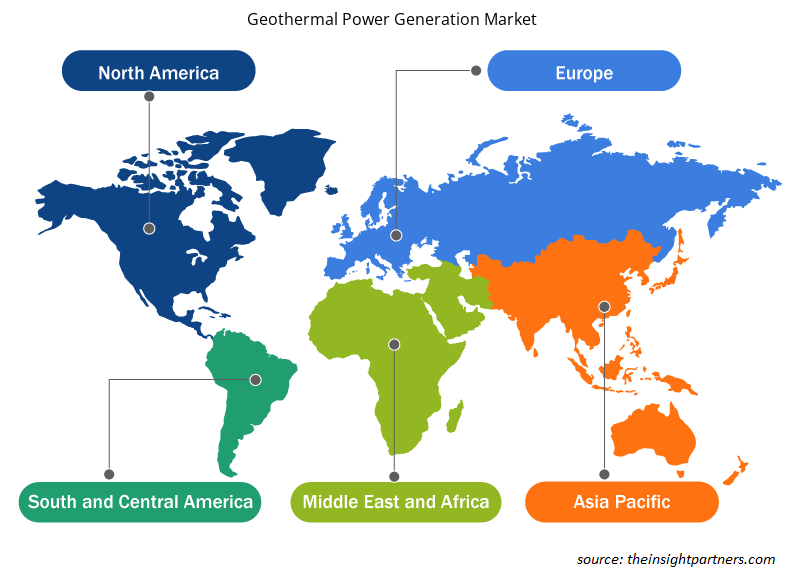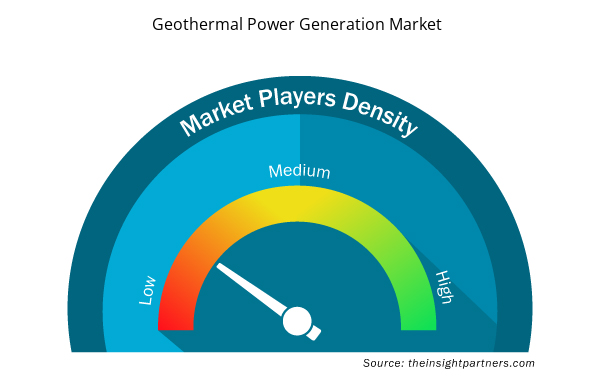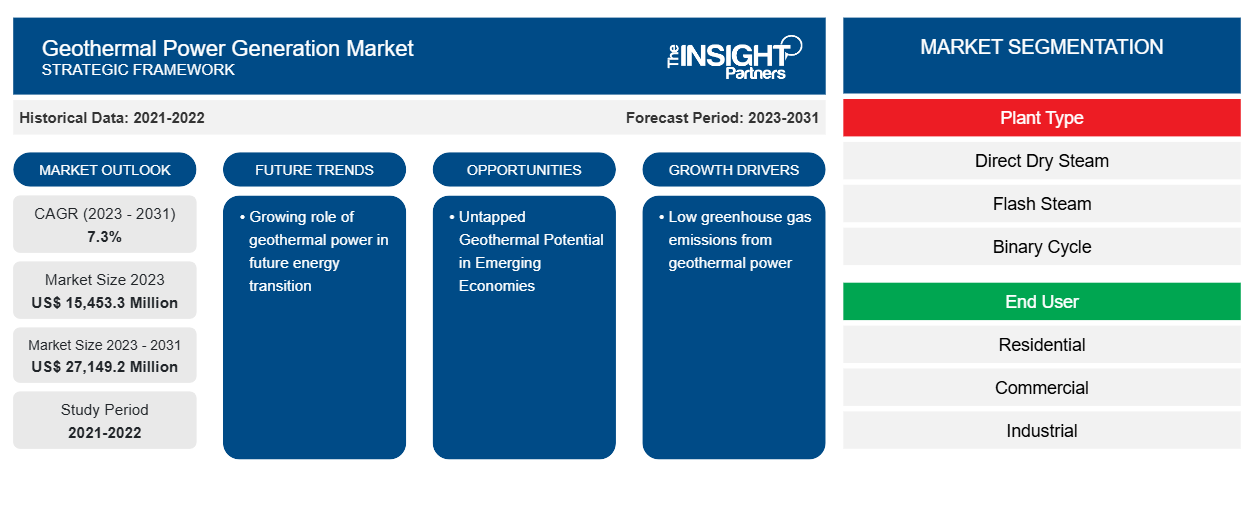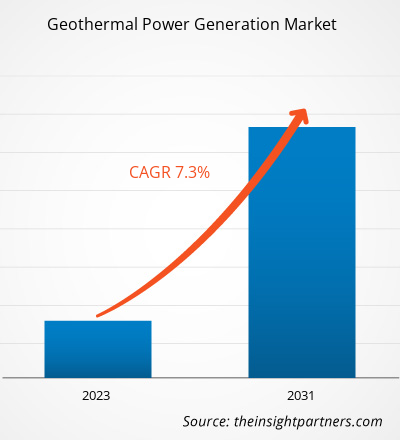من المتوقع أن يصل حجم سوق توليد الطاقة الحرارية الأرضية إلى 27.149.2 مليون دولار أمريكي بحلول عام 2031 من 15.453.3 مليون دولار أمريكي في عام 2023. ومن المتوقع أن يسجل السوق معدل نمو سنوي مركب بنسبة 7.3٪ خلال الفترة 2023-2031. ومن المرجح أن يظل الدور المتزايد للطاقة الحرارية الأرضية في التحول المستقبلي للطاقة هو الاتجاه الرئيسي في السوق.
تحليل سوق توليد الطاقة الحرارية الأرضية
إن توليد الطاقة الحرارية الأرضية هو طريقة نظيفة ومستدامة وصديقة للبيئة تستغل الحرارة الداخلية للأرض لإنتاج الكهرباء. وتتضمن هذه العملية تسخير البخار الطبيعي أو خزانات المياه الساخنة الموجودة تحت سطح الأرض. وقد شكلت محطات توليد الطاقة البخارية السريعة 64.6% من إجمالي حصة سوق توليد الطاقة الحرارية الأرضية على مستوى العالم.
علاوة على ذلك، من المتوقع أن يؤدي الطلب المتزايد على الكهرباء من المستخدمين النهائيين، مثل القطاعات السكنية والتجارية والصناعية، إلى تغذية نمو السوق خلال الفترة المتوقعة. شكل المستخدمون الصناعيون 45.4٪ من إجمالي توليد الطاقة الحرارية الأرضية في العالم، وذلك بسبب ارتفاع الطلب على الكهرباء لمختلف التطبيقات الصناعية مثل التصنيع والكيماويات والبتروكيماويات والمعالجة وغيرها. استحوذت منطقة آسيا والمحيط الهادئ على أكبر حصة في سوق توليد الطاقة الحرارية الأرضية ، أي حوالي 40.4٪، في عام 2022.
نظرة عامة على سوق توليد الطاقة الحرارية الأرضية
يرتبط نمو سوق توليد الطاقة الحرارية الأرضية بالظروف الجيولوجية المواتية للاستفادة من الحرارة الداخلية للأرض. تؤثر جيولوجيا الأرض على التوزيع العالمي للطاقة الحرارية الأرضية، ومن المرجح أن تمتلك المناطق ذات النشاط البركاني العالي أو حدود الصفائح التكتونية أو النقاط الساخنة موارد حرارية أرضية كبيرة. وفي حين كانت بعض المناطق في طليعة تطوير الطاقة الحرارية الأرضية، فإن التطورات الجارية في التكنولوجيا، مثل أنظمة الطاقة الحرارية الأرضية المحسنة (EGS)، تعمل على توسيع نطاق الطاقة الحرارية الأرضية، مما يجعلها خيارًا قابلاً للتطبيق بشكل متزايد للطاقة النظيفة والمستدامة في جميع أنحاء العالم.
تتوافق الطاقة الحرارية الأرضية مع أهداف التحول العالمي في مجال الطاقة، والتي تهدف إلى تقليل انبعاثات الكربون وزيادة الاعتماد على مصادر الطاقة المتجددة. ومع التزام البلدان بالاتفاقيات الدولية مثل اتفاقية باريس، يصبح دور الطاقة الحرارية الأرضية أكثر بروزًا في تحقيق الحياد الكربوني. إن الطبيعة الموثوقة ومنخفضة الكربون للطاقة الحرارية الأرضية تجعلها جزءًا لا يتجزأ من التحول إلى الطاقة النظيفة. تدمج الحكومات في جميع أنحاء العالم الطاقة الحرارية الأرضية في استراتيجيات التحول في مجال الطاقة، وتضع أهدافًا لزيادة قدرة الطاقة المتجددة وتقليل الاعتماد على الوقود الأحفوري. يؤكد التحول العالمي نحو ممارسات الطاقة المستدامة على أهمية الطاقة الحرارية الأرضية في تحقيق أهداف بيئية ومناخية أوسع.
قم بتخصيص هذا التقرير ليناسب متطلباتك
ستحصل على تخصيص لأي تقرير - مجانًا - بما في ذلك أجزاء من هذا التقرير، أو تحليل على مستوى الدولة، وحزمة بيانات Excel، بالإضافة إلى الاستفادة من العروض والخصومات الرائعة للشركات الناشئة والجامعات
- احصل على أهم اتجاهات السوق الرئيسية لهذا التقرير.ستتضمن هذه العينة المجانية تحليلاً للبيانات، بدءًا من اتجاهات السوق وحتى التقديرات والتوقعات.
محركات وفرص سوق توليد الطاقة الحرارية الأرضية
انخفاض انبعاثات الغازات المسببة للاحتباس الحراري من الطاقة الحرارية الأرضية لصالح السوق
إن النمو العالمي في الطلب على الطاقة، مدفوعًا بالنمو السكاني والتصنيع، يتطلب توسيع إنتاج الطاقة. وقد أدى التوسع في إنتاج الطاقة من محطات تعمل بالوقود الأحفوري إلى ارتفاع انبعاثات الغازات المسببة للاحتباس الحراري، ومن المتوقع أن يؤدي هذا بدوره إلى زيادة الحاجة إلى توليد الطاقة المتجددة. وبالتالي، من المتوقع أن يؤدي ارتفاع الطلب على الحد من انبعاثات الغازات المسببة للاحتباس الحراري إلى دفع نمو سوق توليد الطاقة الحرارية الأرضية من عام 2023 إلى عام 2031.
بالإضافة إلى ذلك، تتميز الطاقة الحرارية الأرضية بانبعاثاتها المنخفضة من الغازات المسببة للاحتباس الحراري أثناء البناء والتشغيل. وعلى عكس محطات الطاقة التي تعمل بالوقود الأحفوري، تنتج مرافق الطاقة الحرارية الأرضية الحد الأدنى من ثاني أكسيد الكربون والملوثات الأخرى. وتأتي الانبعاثات في المقام الأول من إطلاق الغازات بكميات صغيرة، مثل كبريتيد الهيدروجين، والتي يتم إدارتها والتخفيف منها بشكل فعال. إن التأثير البيئي للطاقة الحرارية الأرضية أقل بكثير من مصادر الطاقة التقليدية، مما يجعلها خيارًا أنظف وأكثر استدامة. ومع سعي البلدان إلى تقليل بصمتها الكربونية ومكافحة تغير المناخ، فإن ملف الانبعاثات المنخفض للطاقة الحرارية الأرضية يضعها كمكون حاسم في الانتقال إلى مشهد طاقة أكثر خضرة واستدامة.
إمكانات الطاقة الحرارية الأرضية غير المستغلة في الاقتصادات الناشئة
تتدفق الحرارة من باطن الأرض لتغطية ضعف الطلب العالمي على الطاقة. ومن أجل تسخير هذه الحرارة، هناك حاجة إلى الحفر عميقًا تحت الأرض وتحويل تلك الحرارة إلى شكل قابل للاستخدام من الطاقة. وتعتبر هذه عملية صعبة ومكلفة؛ وبالتالي، فإن الطاقة الحرارية الأرضية، التي يشار إليها أحيانًا بالطاقة المتجددة المنسية، لا تمثل سوى حوالي 0.3٪ من إنتاج الكهرباء العالمي. ميزة رئيسية أخرى للطاقة الحرارية الأرضية هي أنها يمكن أن توفر سعة التحميل الأساسية، وهي الحد الأدنى من الكهرباء التي يجب أن تكون متاحة على الشبكة في أي وقت معين. وبينما يتقلب إنتاج الطاقة الشمسية وطاقة الرياح موسميًا وعلى مدار اليوم، يمكن تعديل توليد الطاقة الحرارية الأرضية بنفس الطريقة التي يمكن بها لمحطة الطاقة التي تعمل بالوقود الأحفوري زيادة أو تقليل الإنتاج.
بالإضافة إلى ذلك، فإن المبادرات الحكومية نحو استكشاف الإمكانات غير المستغلة للطاقة الحرارية الأرضية على مستوى العالم. على سبيل المثال، لمساعدة البلدان على إطلاق العنان للإمكانات غير المستغلة للطاقة الحرارية الأرضية وتعزيز استخدامها على نطاق واسع، أنشأت الوكالة الدولية للطاقة المتجددة (IRENA) التحالف العالمي للطاقة الحرارية الأرضية (GGA) في عام 2015 كمنصة لتحسين الحوار والتعاون والعمل المنسق لزيادة حصة الطاقة الحرارية الأرضية المثبتة وكذلك توليد الحرارة في جميع أنحاء العالم. علاوة على ذلك، من المتوقع أن تتصدر إندونيسيا وتركيا وكينيا الاقتصادات الرئيسية في توليد الكهرباء الحرارية الأرضية بحلول نهاية عام 2030. تهدف خطة التنمية الاقتصادية المسماة رؤية كينيا 2030 من قبل حكومة كينيا إلى الوصول إلى 5 جيجاوات من القدرة الحرارية الأرضية بحلول عام 2030. وبالتالي، من المتوقع أن يؤدي استكشاف الإمكانات غير المستغلة للطاقة الحرارية الأرضية في الاقتصادات الناشئة إلى خلق العديد من الفرص لنمو سوق توليد الطاقة الحرارية الأرضية خلال فترة التنبؤ.
تقرير تحليل تجزئة سوق توليد الطاقة الحرارية الأرضية
إن القطاعات الرئيسية التي ساهمت في اشتقاق تحليل سوق توليد الطاقة الحرارية الأرضية هي نوع المصنع والمستخدم النهائي.
- بناءً على نوع المحطة، ينقسم سوق توليد الطاقة الحرارية الأرضية إلى البخار الجاف المباشر والبخار الفوري والدورة الثنائية. احتل قطاع البخار الفوري حصة سوقية أكبر في عام 2023.
- بحسب المستخدم النهائي، يتم تقسيم السوق إلى سكني وتجاري وصناعي. وقد استحوذ القطاع الصناعي على أكبر حصة من السوق في عام 2023.
تحليل حصة سوق توليد الطاقة الحرارية الأرضية حسب المنطقة الجغرافية
ينقسم النطاق الجغرافي لتقرير سوق توليد الطاقة الحرارية الأرضية بشكل أساسي إلى خمس مناطق: أمريكا الشمالية، وآسيا والمحيط الهادئ، وأوروبا، والشرق الأوسط وأفريقيا، وأمريكا الجنوبية والوسطى.
تتصدر منطقة آسيا والمحيط الهادئ السوق. ويرجع هذا إلى الاستثمارات المتزايدة في إضافات سعة الطاقة الحرارية الأرضية وارتفاع الطلب على توليد الطاقة النظيفة في السنوات القادمة. تعد منطقة آسيا والمحيط الهادئ، وخاصة البلدان الواقعة على طول حلقة النار في المحيط الهادئ، غنية بالموارد الحرارية الأرضية. تعد الفلبين مثالاً بارزًا، حيث تأتي حصة كبيرة من الكهرباء من محطات الطاقة الحرارية الأرضية. كما تمتلك إندونيسيا ونيوزيلندا والفلبين واليابان مشاريع نشطة في مجال الطاقة الحرارية الأرضية ومبادرات الاستكشاف. شكلت إندونيسيا ونيوزيلندا والفلبين أكثر من 75٪ من إجمالي حجم سوق توليد الطاقة الحرارية الأرضية العالمية على مستوى العالم في عام 2022 ومن المتوقع أن تحافظ على هيمنتها خلال فترة توقعات سوق توليد الطاقة الحرارية الأرضية.
رؤى إقليمية حول سوق توليد الطاقة الحرارية الأرضية
لقد قام المحللون في Insight Partners بشرح الاتجاهات والعوامل الإقليمية المؤثرة على سوق توليد الطاقة الحرارية الأرضية طوال فترة التوقعات بشكل شامل. يناقش هذا القسم أيضًا قطاعات سوق توليد الطاقة الحرارية الأرضية والجغرافيا في جميع أنحاء أمريكا الشمالية وأوروبا ومنطقة آسيا والمحيط الهادئ والشرق الأوسط وأفريقيا وأمريكا الجنوبية والوسطى.

- احصل على البيانات الإقليمية المحددة لسوق توليد الطاقة الحرارية الأرضية
نطاق تقرير سوق توليد الطاقة الحرارية الأرضية
| سمة التقرير | تفاصيل |
|---|---|
| حجم السوق في عام 2023 | 15,453.3 مليون دولار أمريكي |
| حجم السوق بحلول عام 2031 | 27,149.2 مليون دولار أمريكي |
| معدل النمو السنوي المركب العالمي (2023 - 2031) | 7.3% |
| البيانات التاريخية | 2021-2022 |
| فترة التنبؤ | 2023-2031 |
| القطاعات المغطاة | حسب نوع النبات
|
| المناطق والدول المغطاة | أمريكا الشمالية
|
| قادة السوق وملفات تعريف الشركات الرئيسية |
|
كثافة اللاعبين في سوق توليد الطاقة الحرارية الأرضية: فهم تأثيرها على ديناميكيات الأعمال
يشهد سوق توليد الطاقة الحرارية الأرضية نموًا سريعًا، مدفوعًا بالطلب المتزايد من المستخدم النهائي بسبب عوامل مثل تفضيلات المستهلكين المتطورة والتقدم التكنولوجي والوعي المتزايد بفوائد المنتج. ومع ارتفاع الطلب، تعمل الشركات على توسيع عروضها والابتكار لتلبية احتياجات المستهلكين والاستفادة من الاتجاهات الناشئة، مما يؤدي إلى زيادة نمو السوق.
تشير كثافة اللاعبين في السوق إلى توزيع الشركات أو المؤسسات العاملة في سوق أو صناعة معينة. وهي تشير إلى عدد المنافسين (اللاعبين في السوق) الموجودين في مساحة سوق معينة نسبة إلى حجمها أو قيمتها السوقية الإجمالية.
الشركات الرئيسية العاملة في سوق توليد الطاقة الحرارية الأرضية هي:
- وكالة الطاقة في شمال كاليفورنيا
- توربودين اس بي ايه
- شركة توشيبا لأنظمة الطاقة والحلول
- شركة بيركشاير هاثاواي
- شركة نيب للصناعات
- شركة جنرال الكتريك
إخلاء المسؤولية : الشركات المذكورة أعلاه ليست مرتبة بأي ترتيب معين.

- احصل على نظرة عامة على أهم اللاعبين الرئيسيين في سوق توليد الطاقة الحرارية الأرضية
أخبار سوق توليد الطاقة الحرارية الأرضية والتطورات الأخيرة
يتم تقييم سوق توليد الطاقة الحرارية الأرضية من خلال جمع البيانات النوعية والكمية بعد البحث الأولي والثانوي، والتي تتضمن منشورات الشركات المهمة وبيانات الجمعيات وقواعد البيانات. فيما يلي بعض التطورات في سوق توليد الطاقة الحرارية الأرضية:
- بدأت شركة Fervo Energy العمل في إنشاء محطة توليد الطاقة الحرارية الأرضية من الجيل التالي. تبلغ قدرة هذه المنشأة 400 ميجاوات في مقاطعة بيفر بولاية يوتا. ستستخدم شركة Fervo Energy تقنية الطاقة الحرارية الأرضية المحسنة لتسخير مصادر الحرارة. (المصدر: Fervo Energy، بيان صحفي، سبتمبر 2023)
- وقعت شركة إكسيرجي إنترناشيونال (مقدم تكنولوجيا الطاقة النظيفة) اتفاقية مع شركة إنيرجي ديفيلوبمنت كوربوريشن (EDC) لتوريد محطة طاقة ثنائية بقدرة 28 ميجاوات في ليتي، فيساياس الشرقية (الفلبين). (المصدر: إكسيرجي إنترناشيونال، بيان صحفي، أغسطس 2023)
تغطية تقرير سوق توليد الطاقة الحرارية الأرضية والمنتجات النهائية
يوفر تقرير "حجم سوق توليد الطاقة الحرارية الأرضية والتوقعات (2021-2031)" تحليلاً مفصلاً للسوق يغطي المجالات التالية:
- حجم سوق توليد الطاقة الحرارية الأرضية وتوقعاته على المستويات العالمية والإقليمية والوطنية لجميع قطاعات السوق الرئيسية التي يغطيها النطاق
- اتجاهات سوق توليد الطاقة الحرارية الأرضية بالإضافة إلى ديناميكيات السوق مثل المحركات والقيود والفرص الرئيسية
- تحليل مفصل لـ PEST و SWOT
- تحليل سوق توليد الطاقة الحرارية الأرضية الذي يغطي اتجاهات السوق الرئيسية والإطار العالمي والإقليمي واللاعبين الرئيسيين واللوائح والتطورات الأخيرة في السوق
- تحليل المشهد الصناعي والمنافسة الذي يغطي تركيز السوق، وتحليل خريطة الحرارة، واللاعبين البارزين، والتطورات الأخيرة لسوق توليد الطاقة الحرارية الأرضية
- ملفات تعريف الشركة التفصيلية
- التحليل التاريخي (سنتان)، السنة الأساسية، التوقعات (7 سنوات) مع معدل النمو السنوي المركب
- تحليل PEST و SWOT
- حجم السوق والقيمة / الحجم - عالميًا وإقليميًا وقطريًا
- الصناعة والمنافسة
- مجموعة بيانات Excel



Report Coverage
Revenue forecast, Company Analysis, Industry landscape, Growth factors, and Trends

Segment Covered
This text is related
to segments covered.

Regional Scope
North America, Europe, Asia Pacific, Middle East & Africa, South & Central America

Country Scope
This text is related
to country scope.
الأسئلة الشائعة
7.3% is the expected CAGR of the geothermal power generation market.
US$ 27,149.2 million estimated value of the geothermal power generation market by 2031.
Northern California Power Agency, Turboden SpA, Toshiba Energy Systems & Solutions Corp, Berkshire Hathaway Inc, NIBE Industrier AB, General Electric Co., Fuji Electric Co Ltd, Kenya Electricity Generating Co Ltd, Carrier Global Corp., and Danfoss AS are some of the leading players in the geothermal power generation market.
Growing role of geothermal power in future energy transition is the future trend of the geothermal power generation market
Asia Pacific dominated the geothermal power generation market in 2023.
The List of Companies - Geothermal Power Generation Market
- Northern California Power Agency
- Turboden SpA
- Toshiba Energy Systems & Solutions Corp
- Berkshire Hathaway Inc
- NIBE Industrier AB
- General Electric Co.
- Fuji Electric Co Ltd
- Kenya Electricity Generating Co Ltd
- Carrier Global Corp.
- Danfoss AS
The Insight Partners performs research in 4 major stages: Data Collection & Secondary Research, Primary Research, Data Analysis and Data Triangulation & Final Review.
- Data Collection and Secondary Research:
As a market research and consulting firm operating from a decade, we have published and advised several client across the globe. First step for any study will start with an assessment of currently available data and insights from existing reports. Further, historical and current market information is collected from Investor Presentations, Annual Reports, SEC Filings, etc., and other information related to company’s performance and market positioning are gathered from Paid Databases (Factiva, Hoovers, and Reuters) and various other publications available in public domain.
Several associations trade associates, technical forums, institutes, societies and organization are accessed to gain technical as well as market related insights through their publications such as research papers, blogs and press releases related to the studies are referred to get cues about the market. Further, white papers, journals, magazines, and other news articles published in last 3 years are scrutinized and analyzed to understand the current market trends.
- Primary Research:
The primarily interview analysis comprise of data obtained from industry participants interview and answers to survey questions gathered by in-house primary team.
For primary research, interviews are conducted with industry experts/CEOs/Marketing Managers/VPs/Subject Matter Experts from both demand and supply side to get a 360-degree view of the market. The primary team conducts several interviews based on the complexity of the markets to understand the various market trends and dynamics which makes research more credible and precise.
A typical research interview fulfils the following functions:
- Provides first-hand information on the market size, market trends, growth trends, competitive landscape, and outlook
- Validates and strengthens in-house secondary research findings
- Develops the analysis team’s expertise and market understanding
Primary research involves email interactions and telephone interviews for each market, category, segment, and sub-segment across geographies. The participants who typically take part in such a process include, but are not limited to:
- Industry participants: VPs, business development managers, market intelligence managers and national sales managers
- Outside experts: Valuation experts, research analysts and key opinion leaders specializing in the electronics and semiconductor industry.
Below is the breakup of our primary respondents by company, designation, and region:

Once we receive the confirmation from primary research sources or primary respondents, we finalize the base year market estimation and forecast the data as per the macroeconomic and microeconomic factors assessed during data collection.
- Data Analysis:
Once data is validated through both secondary as well as primary respondents, we finalize the market estimations by hypothesis formulation and factor analysis at regional and country level.
- Macro-Economic Factor Analysis:
We analyse macroeconomic indicators such the gross domestic product (GDP), increase in the demand for goods and services across industries, technological advancement, regional economic growth, governmental policies, the influence of COVID-19, PEST analysis, and other aspects. This analysis aids in setting benchmarks for various nations/regions and approximating market splits. Additionally, the general trend of the aforementioned components aid in determining the market's development possibilities.
- Country Level Data:
Various factors that are especially aligned to the country are taken into account to determine the market size for a certain area and country, including the presence of vendors, such as headquarters and offices, the country's GDP, demand patterns, and industry growth. To comprehend the market dynamics for the nation, a number of growth variables, inhibitors, application areas, and current market trends are researched. The aforementioned elements aid in determining the country's overall market's growth potential.
- Company Profile:
The “Table of Contents” is formulated by listing and analyzing more than 25 - 30 companies operating in the market ecosystem across geographies. However, we profile only 10 companies as a standard practice in our syndicate reports. These 10 companies comprise leading, emerging, and regional players. Nonetheless, our analysis is not restricted to the 10 listed companies, we also analyze other companies present in the market to develop a holistic view and understand the prevailing trends. The “Company Profiles” section in the report covers key facts, business description, products & services, financial information, SWOT analysis, and key developments. The financial information presented is extracted from the annual reports and official documents of the publicly listed companies. Upon collecting the information for the sections of respective companies, we verify them via various primary sources and then compile the data in respective company profiles. The company level information helps us in deriving the base number as well as in forecasting the market size.
- Developing Base Number:
Aggregation of sales statistics (2020-2022) and macro-economic factor, and other secondary and primary research insights are utilized to arrive at base number and related market shares for 2022. The data gaps are identified in this step and relevant market data is analyzed, collected from paid primary interviews or databases. On finalizing the base year market size, forecasts are developed on the basis of macro-economic, industry and market growth factors and company level analysis.
- Data Triangulation and Final Review:
The market findings and base year market size calculations are validated from supply as well as demand side. Demand side validations are based on macro-economic factor analysis and benchmarks for respective regions and countries. In case of supply side validations, revenues of major companies are estimated (in case not available) based on industry benchmark, approximate number of employees, product portfolio, and primary interviews revenues are gathered. Further revenue from target product/service segment is assessed to avoid overshooting of market statistics. In case of heavy deviations between supply and demand side values, all thes steps are repeated to achieve synchronization.
We follow an iterative model, wherein we share our research findings with Subject Matter Experts (SME’s) and Key Opinion Leaders (KOLs) until consensus view of the market is not formulated – this model negates any drastic deviation in the opinions of experts. Only validated and universally acceptable research findings are quoted in our reports.
We have important check points that we use to validate our research findings – which we call – data triangulation, where we validate the information, we generate from secondary sources with primary interviews and then we re-validate with our internal data bases and Subject matter experts. This comprehensive model enables us to deliver high quality, reliable data in shortest possible time.


 احصل على عينة مجانية لهذا التقرير
احصل على عينة مجانية لهذا التقرير